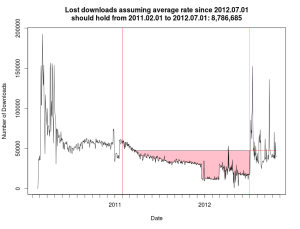What about an Open Web Health Report?
September 8, 2013
 We often talk about the “Open Web” or “the web as a platform” and it certainly resonates from some, but for others, not so much. It’s a murky concept for sure. Prior to my time at Mozilla, I must admit that I didn’t spend a lot of cycles thinking about the web as a platform, what’s important about it, the key attributes, much less its health. Like most of us, I just used it and assumed it would always be there. My sense is that people think about the open web about as much as they did the “environment” before the environmental movement first gained broad traction in the early ’70s.
We often talk about the “Open Web” or “the web as a platform” and it certainly resonates from some, but for others, not so much. It’s a murky concept for sure. Prior to my time at Mozilla, I must admit that I didn’t spend a lot of cycles thinking about the web as a platform, what’s important about it, the key attributes, much less its health. Like most of us, I just used it and assumed it would always be there. My sense is that people think about the open web about as much as they did the “environment” before the environmental movement first gained broad traction in the early ’70s.
Given that much of Mozilla’s mission is about nurturing and creating a healthy web environment, it seems we should have some way to understand and track its health. Just like a doctor wants to understand your symptoms before treatment, or a business tracks its inventory, maybe we need the same thing for the open web. Perhaps there’s a need for some kind of report that tracks key metrics that would give us qualitative and quantitative insight into the health of this so called open web.
There are plenty of reports that monitor traffic like Keynote or Akami’s State of the Internet report that highlights attack traffic, connection speeds, Internet penetration, etc. These are all good but there’s more to the health of the open web than traffic, speed, and adoption.
A clear understanding of the current state and trends should inform our strategy and let us know where, when, and if we have been successful. It would also tell us when we weren’t. Knowing the problem is certainly the first step to solutions. Ten years ago when one browser had roughly 90% market share it was easy to see the problem. Today – not so much.
So how would you do it? First there would have to be some common understanding of the attributes of the open web we want to monitor. This itself is no easy task, but the 80/20 rule seems applicable here. Tantek did some great work a few years ago when he articulated three principle abilities that were essential to the “open web” namely:
- publish content and applications on the web in open standards
- code and implement the web standards that that content/apps depend on
- access and use content / code / web-apps / implementations
In “Long Live the Web: A Call for Continued Open Standards and Neutrality” Tim Berners-Lee articulated universality as the key principle of the web. He also noted that “some of its most successful inhabitants have begun to chip away at its principles.” The FCC’s Open Internet Order articulated four key concepts that encapsulate the idea of net neutrality – one core principle. Google’s Sergey Brin described some of the same principles and threats in a 2012 Guardian interview. In some of our public policy work we attempted to identify “open web DNA” so we could better address policy threats. These all assume the existence of some common set of principles that underpin the open web.
The world is even more complicated today and I would posit that there are a wide range of additional metrics that collectively indicate the health of the open web and the vitality of the principles we care about. Many of these are not the traditional technical components, but commercial and external market factors that could serve as indicators for the abilities described above. For example, it may include factors like:
- Diversity of service providers and ecosystems
- Concentration of service providers, publishers, and applications
- Adoption of open standards, APIs and languages
- Security
- User choice and control
- Public awareness and activism
- Content restrictions
- Transparency
- Interoperability
- HTML5 developers
- Relevant economic/growth indicators
- Usage patterns and trends
- Maybe even a disruption index
If this kind of report already exists, let’s use it more. If it doesn’t should we try to create it?

